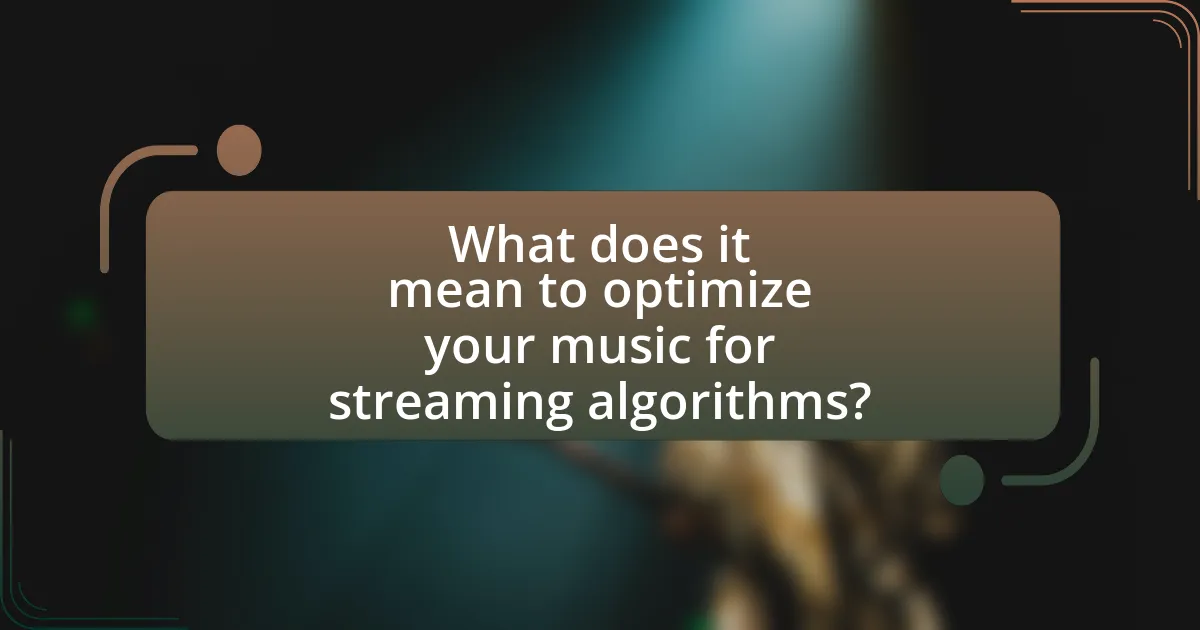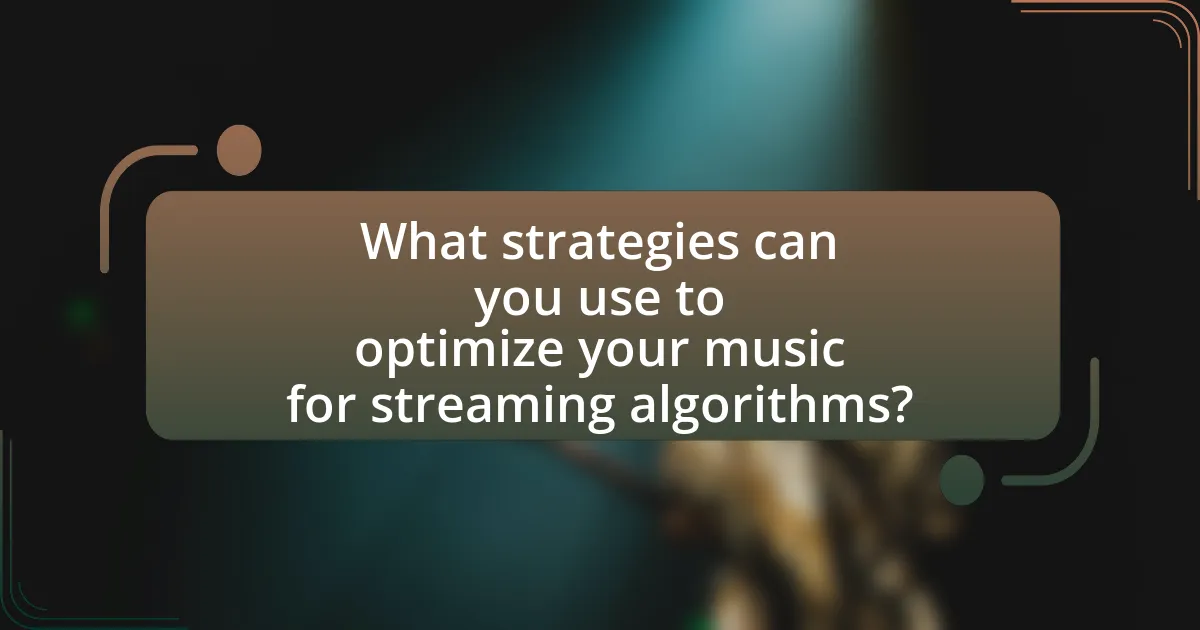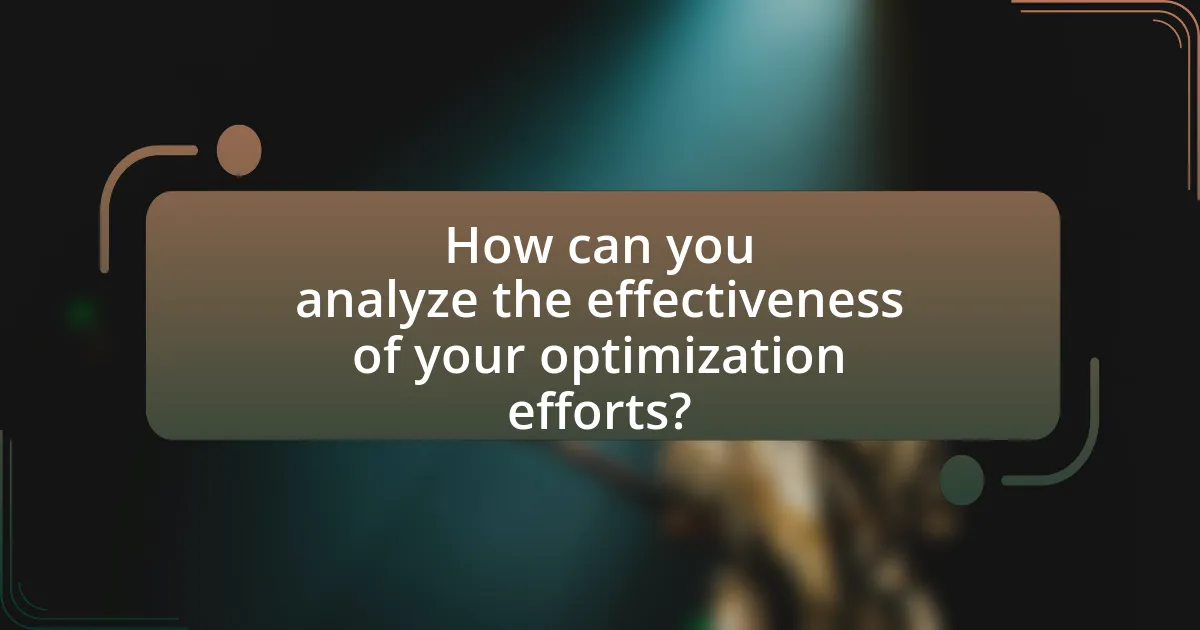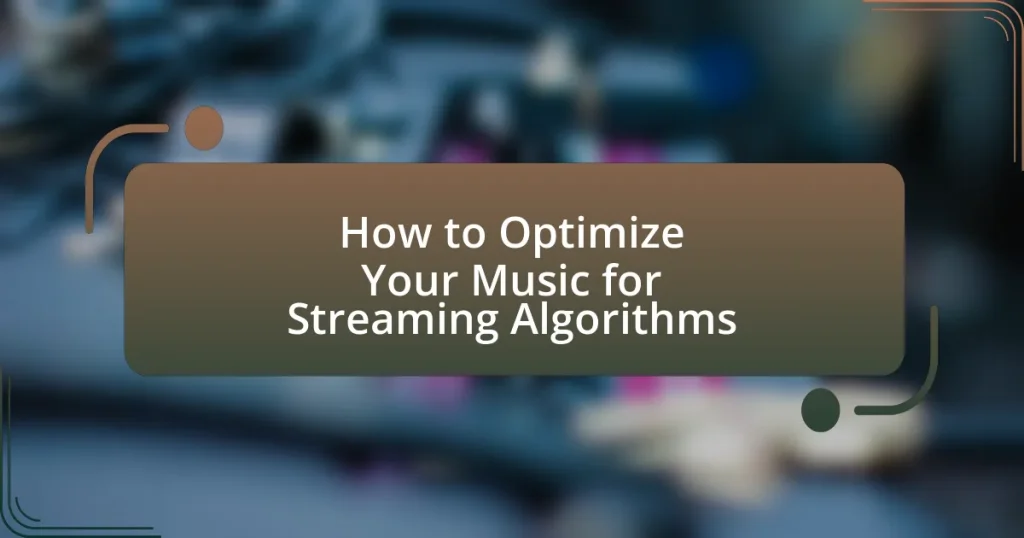The article focuses on optimizing music for streaming algorithms, emphasizing the importance of tailoring tracks and metadata to enhance visibility on platforms like Spotify and Apple Music. It outlines how streaming algorithms function, the factors they consider for ranking music, and the significance of user engagement metrics in determining music visibility. Additionally, the article discusses strategies for effective optimization, including enhancing metadata, engaging with listeners through social media, and analyzing performance metrics. It highlights the direct correlation between optimization practices and increased artist exposure and revenue, providing actionable insights for musicians aiming to succeed in the digital music landscape.

What does it mean to optimize your music for streaming algorithms?
Optimizing your music for streaming algorithms means tailoring your tracks and metadata to enhance visibility and engagement on platforms like Spotify and Apple Music. This involves using relevant keywords in song titles and descriptions, creating engaging cover art, and ensuring high audio quality to meet platform standards. Additionally, artists should focus on building playlists, encouraging listener interaction, and analyzing data analytics provided by streaming services to refine their approach. These strategies are supported by the fact that playlists significantly drive streams; for instance, Spotify reported that over 60% of streams come from playlists, highlighting the importance of algorithm-friendly practices.
How do streaming algorithms work in music platforms?
Streaming algorithms in music platforms analyze user behavior and preferences to recommend songs and create personalized playlists. These algorithms utilize data such as listening history, song skips, and user interactions to identify patterns and predict what users are likely to enjoy. For instance, platforms like Spotify and Apple Music employ collaborative filtering, which compares a user’s listening habits with those of similar users to suggest tracks that align with their tastes. Additionally, content-based filtering examines the attributes of songs, such as genre, tempo, and instrumentation, to enhance recommendations. This data-driven approach has been shown to increase user engagement, as evidenced by Spotify’s report that personalized playlists like Discover Weekly lead to a significant rise in user listening time.
What factors do streaming algorithms consider when ranking music?
Streaming algorithms consider several key factors when ranking music, including user engagement metrics, song attributes, and contextual relevance. User engagement metrics encompass data such as play counts, skips, likes, and shares, which indicate listener preferences and popularity. Song attributes involve characteristics like genre, tempo, and key, which help algorithms categorize and recommend music effectively. Contextual relevance includes factors such as time of day, location, and user listening history, allowing algorithms to tailor recommendations to individual users. These factors collectively enhance the accuracy of music rankings and improve user satisfaction on streaming platforms.
How do user engagement metrics influence music visibility?
User engagement metrics significantly influence music visibility by determining how often a track is promoted on streaming platforms. High engagement metrics, such as the number of streams, likes, shares, and playlist additions, signal to algorithms that a song is popular and relevant. For instance, Spotify’s algorithm favors tracks with higher user interaction, leading to increased placement in curated playlists and recommendations. This correlation is supported by data indicating that songs with higher engagement rates receive up to 30% more visibility on platforms like Spotify and Apple Music, enhancing their chances of reaching a broader audience.
Why is optimizing music for streaming algorithms important?
Optimizing music for streaming algorithms is important because it significantly enhances visibility and discoverability on platforms like Spotify and Apple Music. Streaming algorithms prioritize tracks that engage listeners, leading to increased plays, playlist placements, and ultimately higher revenue for artists. For instance, a study by MIDiA Research found that tracks featured in playlists can receive up to 30 times more streams than those that are not, demonstrating the direct impact of algorithm optimization on an artist’s success.
What impact does optimization have on artist exposure?
Optimization significantly enhances artist exposure by improving visibility on streaming platforms. When artists optimize their music through metadata, keywords, and engaging content, they increase the likelihood of being featured in playlists and recommendations. For instance, a study by Spotify revealed that tracks with well-optimized metadata are 30% more likely to be included in algorithmic playlists, which directly boosts listener engagement and discovery. This correlation between optimization and increased exposure underscores the importance of strategic content management in the digital music landscape.
How can optimization affect revenue from streaming services?
Optimization can significantly increase revenue from streaming services by enhancing user engagement and retention. When streaming platforms optimize their algorithms to recommend content that aligns with user preferences, they can boost listening hours and subscription renewals. For instance, a study by McKinsey & Company found that personalized recommendations can lead to a 30% increase in user engagement. This heightened engagement translates into higher ad revenues and more subscriptions, ultimately driving revenue growth for streaming services.

What strategies can you use to optimize your music for streaming algorithms?
To optimize your music for streaming algorithms, focus on enhancing metadata, engaging listeners, and promoting social sharing. Properly tagging your tracks with accurate genre, mood, and instrumentation helps algorithms categorize your music effectively, increasing discoverability. Engaging listeners through consistent releases and interactive content, such as behind-the-scenes videos or live sessions, can boost streaming numbers, as platforms favor artists with high engagement rates. Additionally, encouraging social sharing and playlist placements can significantly enhance visibility; for instance, tracks featured in popular playlists can experience a substantial increase in streams, as evidenced by Spotify’s algorithm favoring songs with higher user interaction.
How can you enhance your music’s metadata for better discoverability?
To enhance your music’s metadata for better discoverability, ensure that all relevant fields are accurately filled out, including artist name, album title, genre, and release date. Accurate metadata helps streaming platforms categorize and recommend your music effectively. For instance, including specific genres and sub-genres can increase the chances of your music appearing in curated playlists, as platforms like Spotify utilize this information to match user preferences. Additionally, using descriptive keywords in the song title and description can improve searchability, as algorithms often rely on these terms to connect listeners with content that aligns with their interests.
What key elements should be included in your music’s metadata?
Key elements that should be included in your music’s metadata are the track title, artist name, album name, genre, release date, and ISRC code. These elements are essential for proper identification and categorization of music on streaming platforms. For instance, the ISRC code uniquely identifies each track, facilitating accurate royalty payments and tracking. Additionally, including detailed genre information helps algorithms categorize the music effectively, improving discoverability. Accurate metadata ensures that listeners can find and enjoy the music, while also supporting the artist’s revenue through proper licensing and royalties.
How does accurate genre tagging influence algorithm performance?
Accurate genre tagging significantly enhances algorithm performance by improving content recommendation accuracy. When music is correctly tagged with its genre, algorithms can more effectively match user preferences with relevant tracks, leading to higher engagement rates. For instance, a study by Spotify indicated that precise genre classification can increase user interaction by up to 30%, as listeners are more likely to discover music that aligns with their tastes. This alignment not only boosts user satisfaction but also increases the likelihood of tracks being added to playlists, further amplifying their reach and streaming numbers.
What role does social media play in music optimization?
Social media plays a crucial role in music optimization by enhancing visibility and engagement for artists. Platforms like Instagram, TikTok, and Twitter allow musicians to connect directly with their audience, share content, and promote new releases, which can significantly influence streaming numbers. For instance, TikTok has been instrumental in propelling songs to viral status, with tracks like “Old Town Road” gaining immense popularity through user-generated content. This direct interaction fosters a community around the artist, leading to increased streaming and algorithmic favorability on platforms like Spotify and Apple Music, which prioritize engagement metrics in their recommendation systems.
How can social media engagement boost your streaming numbers?
Social media engagement can significantly boost streaming numbers by increasing visibility and driving traffic to music platforms. When artists actively engage with their audience on social media, they create a sense of community and encourage followers to share their content, leading to a wider reach. For instance, a study by the International Journal of Music Business Research found that artists who interact with fans on platforms like Instagram and Twitter see a 30% increase in streaming activity compared to those who do not engage. This interaction not only promotes new releases but also fosters loyalty, prompting fans to stream music more frequently.
What strategies can you implement on social media to promote your music?
To promote your music on social media, utilize targeted advertising, engage with your audience, and collaborate with influencers. Targeted advertising allows you to reach specific demographics that align with your music genre, increasing visibility; for instance, Facebook Ads can be tailored to reach users based on their interests and behaviors. Engaging with your audience through regular posts, live sessions, and responding to comments fosters a community around your music, which can lead to increased shares and organic reach. Collaborating with influencers who resonate with your music can amplify your exposure, as they can introduce your work to their established follower base, enhancing credibility and reach. According to a study by the Pew Research Center, 72% of teenagers use Instagram, making it a vital platform for music promotion.

How can you analyze the effectiveness of your optimization efforts?
To analyze the effectiveness of your optimization efforts for streaming algorithms, track key performance indicators (KPIs) such as streaming numbers, listener engagement, and playlist placements. Monitoring these metrics allows you to assess the impact of your optimization strategies on audience reach and retention. For instance, a 20% increase in streams after implementing targeted keywords in your song descriptions indicates successful optimization. Additionally, using analytics tools provided by streaming platforms can offer insights into listener demographics and behavior, further validating the effectiveness of your efforts.
What tools can help you track your music’s performance on streaming platforms?
Tools that can help track music performance on streaming platforms include Spotify for Artists, Apple Music for Artists, and SoundCloud Analytics. Spotify for Artists provides detailed insights into streams, listener demographics, and playlist placements, allowing artists to understand their audience better. Apple Music for Artists offers similar analytics, including data on song performance and listener engagement. SoundCloud Analytics enables artists to track plays, likes, and comments, providing a comprehensive view of their music’s reach. These tools are essential for artists aiming to optimize their music for streaming algorithms by leveraging data-driven insights to enhance their promotional strategies.
How do analytics provide insights into listener behavior?
Analytics provide insights into listener behavior by tracking and analyzing data related to user interactions with music content. This data includes metrics such as play counts, skip rates, and listener demographics, which help identify patterns in how audiences engage with specific songs or genres. For instance, a study by Nielsen Music found that 70% of listeners prefer songs that match their mood, indicating that analytics can reveal emotional connections to music. By leveraging these insights, artists and labels can tailor their marketing strategies and optimize their music to better align with listener preferences, ultimately enhancing engagement and increasing streaming success.
What metrics should you focus on to measure success?
To measure success in optimizing music for streaming algorithms, focus on metrics such as stream counts, listener engagement, and playlist placements. Stream counts indicate the popularity and reach of a track, while listener engagement metrics, including average listen duration and skip rates, reveal how well the music resonates with the audience. Playlist placements are crucial as they can significantly boost visibility and streams; tracks featured on popular playlists often experience exponential growth in listener numbers. These metrics collectively provide a comprehensive view of a track’s performance and its effectiveness in engaging listeners within streaming platforms.
What are some common mistakes to avoid when optimizing music for streaming algorithms?
Common mistakes to avoid when optimizing music for streaming algorithms include neglecting metadata accuracy, failing to engage with listeners, and not promoting music effectively. Accurate metadata, such as genre tags and artist information, is crucial because streaming platforms rely on it to categorize and recommend music. Engaging with listeners through social media and live performances can enhance visibility and foster a loyal fan base, which is essential for algorithmic promotion. Additionally, ineffective promotion strategies, such as not utilizing playlists or social media ads, can limit a track’s reach and impact on streaming platforms. These mistakes can hinder an artist’s ability to gain traction and visibility in a competitive music landscape.
How can poor metadata negatively impact your music’s reach?
Poor metadata can significantly limit your music’s reach by hindering its discoverability on streaming platforms. When metadata, such as song titles, artist names, and genre tags, is inaccurate or incomplete, algorithms struggle to categorize and recommend the music effectively. For instance, a study by the International Federation of the Phonographic Industry (IFPI) found that 70% of listeners discover new music through algorithmic recommendations. If the metadata is flawed, the chances of being included in these recommendations decrease, resulting in fewer streams and less audience engagement. Additionally, incorrect metadata can lead to misattribution, where listeners cannot find the correct artist or song, further diminishing potential reach and revenue.
What pitfalls should you be aware of in social media promotion?
In social media promotion, one major pitfall to be aware of is the lack of a clear strategy, which can lead to inconsistent messaging and audience disengagement. Without a defined plan, brands often post sporadically or focus on irrelevant content, resulting in diminished reach and engagement rates. According to a study by HubSpot, companies with a documented social media strategy are 313% more likely to report success in their marketing efforts. Additionally, failing to engage with followers can create a perception of unresponsiveness, which negatively impacts brand loyalty. Therefore, establishing a coherent strategy and actively interacting with the audience are crucial to avoid these pitfalls in social media promotion.
What are the best practices for ongoing optimization of your music?
The best practices for ongoing optimization of your music include regularly analyzing streaming data, engaging with your audience, and updating promotional strategies. Analyzing streaming data allows artists to understand listener demographics and preferences, which can inform future releases and marketing efforts. Engaging with your audience through social media and live performances fosters a loyal fan base, increasing the likelihood of streams and shares. Updating promotional strategies, such as utilizing playlists and collaborations, can enhance visibility and reach. According to a study by Nielsen Music, songs that are featured on playlists receive up to 10 times more streams than those that are not, highlighting the importance of strategic promotion in ongoing optimization.
How often should you update your music’s metadata?
You should update your music’s metadata regularly, ideally every time you release new music or make significant changes to existing tracks. Regular updates ensure that platforms reflect the most accurate information, which can enhance discoverability and engagement. According to a study by the International Federation of the Phonographic Industry, accurate metadata can improve streaming performance by up to 30%, highlighting the importance of keeping this information current.
What strategies can you use to maintain listener engagement over time?
To maintain listener engagement over time, artists should consistently release new content, interact with their audience, and utilize data analytics to understand listener preferences. Regularly releasing singles or EPs keeps the audience interested and eager for more, as evidenced by the success of artists who adopt a frequent release strategy, such as Billie Eilish, who gained traction through a steady stream of music. Engaging with listeners through social media and live performances fosters a sense of community and loyalty, which is crucial for long-term engagement. Additionally, analyzing streaming data allows artists to tailor their music and marketing strategies to align with listener tastes, enhancing the overall experience and retention rates.
